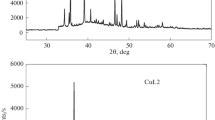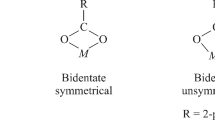Abstract
Tribochemical reactions of KBr, KI and CaI2 with [Cu(L)Cl2(EtOH)3/2(H2O)]1/2H2O (L = formylhydrazine) give novel CuI and CuII complexes, which have been characterized by elemental analyses, spectral (i.r., u.v.–vis., 1H-n.m.r.) and magnetic measurements. The i.r. spectra indicate that (L) behaves in a monodentate manner, coordinating via the azomethine nitrogen (C-N) group in the CuII complexes, but behaving as a bidentate ligand, via the carbonyl oxygen and NH2 groups in the CuI complexes. KI and CaI2 react with [Cu(L)Cl2(EtOH)3/2(H2O)]-1/2H2O in the solid state, accompanied by a colour change, substitution of the chloride by iodide ions, and reduction of CuII to CuI to give complexes with formulae [Cu(L)I(EtOH)1/2] and [Cu1.7(L)I1.7(EtOH)1/2]. On the other hand, the tribochemical reaction of KBr with [Cu(L)Cl2(EtOH)3/2(H2O)]1/2H2O is accompanied by a colour change; substitution of the chloride by bromide ions, but without reduction of CuII and yields a complex of formula [Cu(L)2Br2(EtOH)(H2O)]1/2EtOH. The spectral and magnetic results suggest a distorted octahedral geometry for the CuII complexes while a tetrahedral geometry around the CuI ion. The non-stoichiometric structure of [Cu1.7(L)I1.7(EtOH)1/2] is discussed.
Similar content being viewed by others
References
M.M. Mostafa, E.A.H. Gomaa, M.A. Mostafa and F.I. El-Dossouki, Spectrochim. Acta, 55, 2869 (1999).
M.M. Mostafa, E.A.H. Gomaa, M.A. Mostafa and F.I. El-Dossouki, Syn. React. Inorg. Met.-Org. Chem., 30, 157 (2000).
M.M. Mostafa and M.H. Abdel-Rhman, Spectrochim. Acta A, 56, 2341 (2000).
G. Pellizari, Gazz. Chim. Ital., 24, 225 (1894).
E.M. Shoukry, H.A. Bayoumi and M.M. Mostafa, Transition Met. Chem., 25, 73 (2000).
W.J. Geary, Coord. Chem. Revs., 7, 81 (1971).
S.E. Livingstone and J.E. Cluka, Transition Met. Chem., 3, 261 (1978).
M. Mashima, Bull. Chem. Soc. (Japan), 35, 1882 (1962).
M. Masui and H. Ohmori, J. Chem. Soc., A, 153 (1969).
A. Rosenberg, Acta Chem. Scand., 11, 1390 (1957).
A. Yamaguchi, J. Chem. Soc. (Japan), 80, 1105, 1109 (1959).
J.R. Ferraro, Low Frequency Vibrations of Inorganic and Coordination Compounds, Plenum press, New York, 1971.
M. Kato, H.B. Jonassen and J.C. Fanning, Chem. Rev., 64, 99 (1964).
A.B.P. Lever, Inorganic Electronic Spectroscopy, Elsevier, Amsterdam, 1968.
Author information
Authors and Affiliations
Rights and permissions
About this article
Cite this article
Mostafa, M.M., El-Shazly, R.M., Rakha, T.H. et al. The dangers of using KBr, KI and CaI2 as mulling agents during the preparation of infrared discs of complexes. Transition Metal Chemistry 27, 337–340 (2002). https://doi.org/10.1023/A:1014830319501
Issue Date:
DOI: https://doi.org/10.1023/A:1014830319501




